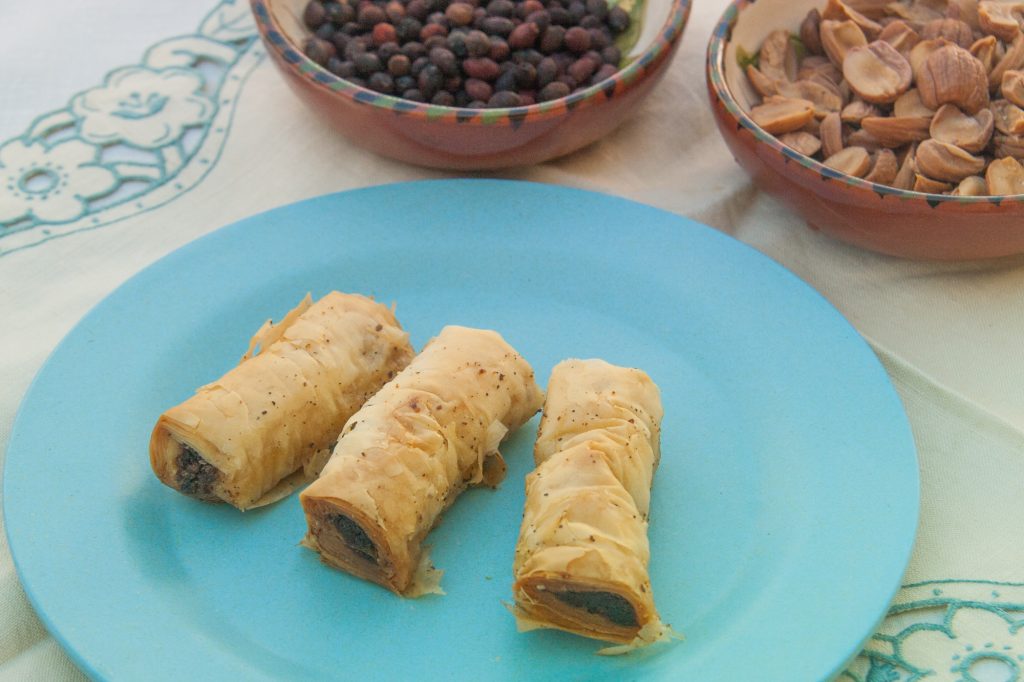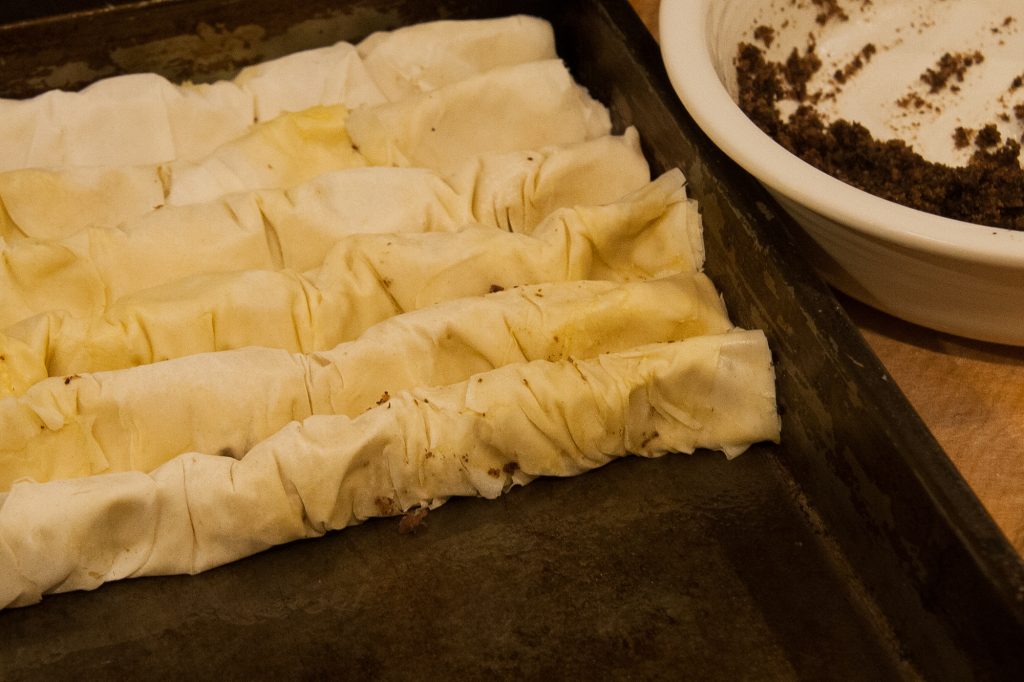
When I was in Wisconsin last month, I taught a Forage to Table weekend with Melissa Price. We made a hortopita, and talked about other foraged foods we could make with phyllo dough. We also worked with acorns that weekend, and Sharon Hahn (thank you, Sharon Hahn!) asked if I’d ever made acorn baklava. “Why no, Sharon, I never thought of that. But that’s a helluva good idea!” I promised Sharon credit for inspiring this recipe, and boy does she deserve it. I’m not sure I ever would have thought of it myself.
I’ve been making baklava since before I hit puberty. It’s one of my go-to desserts when I want to impress, because really, once you get the hang of phyllo dough, baklava isn’t very hard to make. I do NOT use honey in my syrup, I prefer many light layers of filling to fewer, thick layers, and I use a fine grind for my nuts. Why? Because that’s how my yiayia made baklava, and that’s how I like it.
That being said, Yiayia might NOT appreciate my foraged acorn baklava. Not simply because I’m messing with the family recipe, but also because acorns were famine food in much of Greece, a reminder of tough times.
Plus, I’ve taken a few more liberties with this recipe. For more than 40 years I’ve made baklava in a sheet pan, cut into diamond shapes, filled with walnuts, cinnamon, and nutmeg, and topped with cloves. My acorn baklava uses spicebush berries instead of the traditional trio of warm spices. Also, this recipe is technically for a saragli, a rolled baklava. Heresy, right?
I actually made my first acorn baklava in a traditional, flat shape. But that recipe failed. Not because of the shape of the baklava, but because the acorns themselves were too hard. When I realized I had to try again (because giving up was not an option), I thought, “Why not mix it up a little?” Turns out I love the saragli! They’re easier to assemble than the traditional, flat baklava, and easier to pick up with your fingers and rapidly shovel into your mouth.
Now, a word about those too-hard nuts. I use hot-leached acorns for this recipe. (To read more about the different ways you can leach and use acorns, see here.) To preserve the shelf life of hot leached acorns, I usually dry the leached nut meats, then store them in the freezer. Nuts preserved this way are dry and hard, and while the flavor of the baklava was excellent, the texture was not. I remembered how soft the acorns were when I took them out of the boiling water, and I thought soaking the nut meats overnight might soften them up just the right amount. Yay, it worked!
Ok, I’m feeling a little long-winded here. How about if I just get to the recipe?
What You’ll Need to Make Acorn Baklava
for the pastries:
- 1 package commercial phyllo dough
- butter spray
- 2 cups leached, softened acorn meats (this will reduce to about 1 1/2 cups when ground)
- 1/2 cup sugar
- 2 Tablespoons dried, ground spicebush berries (you may substitute a combination of cinnamon and nutmeg)
for the syrup:
- 1 Tablespoon dried, ground spicebush berries
- 1 1/4 cups water
- 2 cups sugar
- 2 Tablespoons lemon juice
What You’ll Do to Make Acorn Baklava
Preheat your oven to 350F.
In a food processor, pulse the acorns to a medium-fine grind. There should be some texture, but no big chunks. (Conversely, you don’t want a paste or a fine flour, so don’t over-grind.) Transfer the nuts to a bowl, add the sugar and ground spicebush berries, and stir to combine. Set the bowl aside.
Unwrap and unroll your phyllo dough. Take a clean dish towel, soak it thoroughly with water, squeeze out the excess, then drape it over the unrolled phyllo. The moisture in the towel will keep the dough pliable. Otherwise, because phyllo dough is so thin, it will dry out and crumble.
Phyllo dough comes in various sizes, but is usually in the neighborhood of 13″ x 18″. This recipe is for an 9″ x 13″ pan, so you’ll need to trim your phyllo. Cut the dough to be one inch larger than the pan both lengthwise and crosswise (in this case, 10″ x 14″). Thoroughly coat the pan with butter spray, and set it aside.
Lay one sheet of the trimmed phyllo on a clean cutting board and spray lightly with the butter spray. Place another piece of phyllo on top of the first, and again, spray lightly with butter spray. Add a third sheet, and spray it also. Sprinkle 1/4 cup of the nut mixture across the short, bottom edge of the phyllo, and roll the dough, starting at the bottom. Keep the roll as tight as possible. Turn the roll so the seam is facing down, then, holding the roll at each end, push the ends in toward each other, gently scrunching up the roll, giving it a wrinkled appearance. Then place the roll in the pan. (This is why you cut the phyllo dough just slightly larger than the pan. Once you scrunch the roll, it should fit the pan perfectly.

Repeat the above process for as long as the phyllo and nut mixture last. When all the pastries are in the pan, spray the tops heavily with butter spray, and cut the rolls into smaller lengths, two or three inches long). Bake for a half hour at 350F, then reduce the heat to 300F and bake for another 30 minutes.
While the pastries are in the oven, assemble your syrup. You want it to be room temperature (or colder) when the hot pastries come out of the oven. I don’t know why, but traditional Greek syrup-pastry recipes always say to either pour hot syrup on cold pastry or cold syrup on hot pastry. Maybe there’s a scientific explanation or maybe it’s a baseless old wives’ tale. I’m not going to argue with this one; I’ve broken with enough traditions on this recipe already.
In a saucepan, combine the sugar, water, and ground spicebush berries. Whisk over medium heat to dissolve the sugar, and let the syrup simmer for a few minutes. Add the lemon juice, remove the pan from the heat, and allow the syrup to cool.
After an hour in the oven, the acorn baklava should be golden brown. Pour the syrup evenly over the pastries and listen to the sizzle as hot and cold meet. Let the baklava absorb the syrup for at least an hour before serving. Cover any uneaten pastries; they’ll keep for two weeks in the refrigerator.
Now if you’ll excuse me, I have to put a few pieces of acorn baklava in the mail to Sharon. It’s the least I can do to thank her for the inspiration.

[…] Acorn Baklava […]